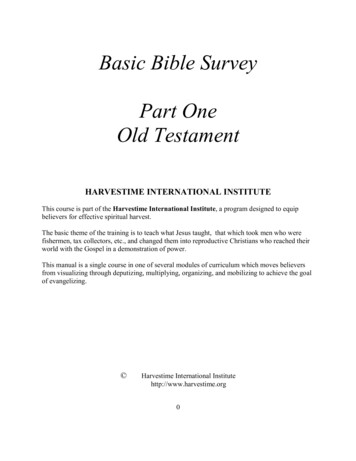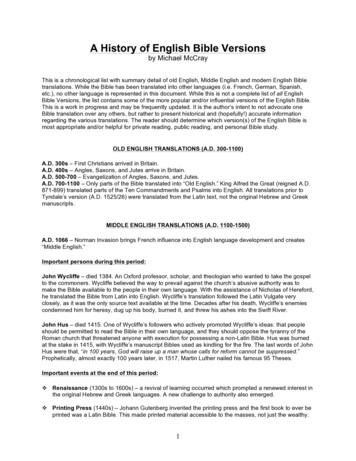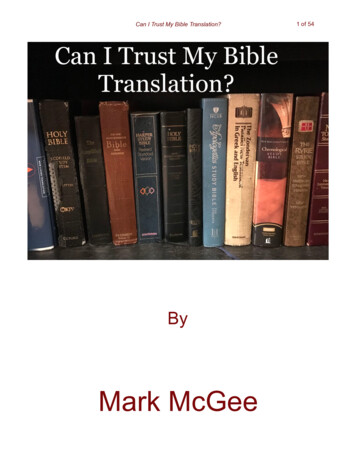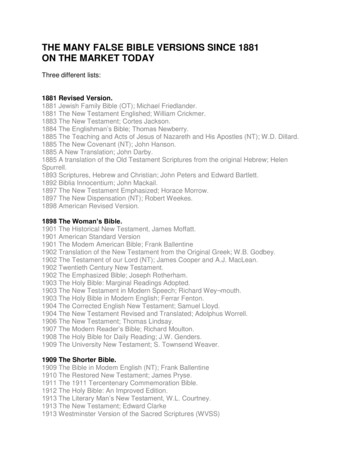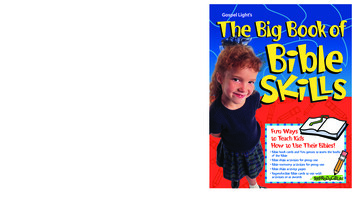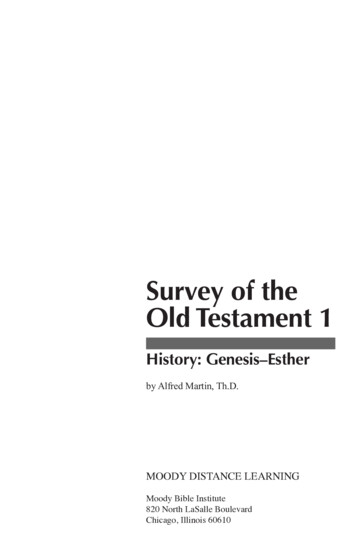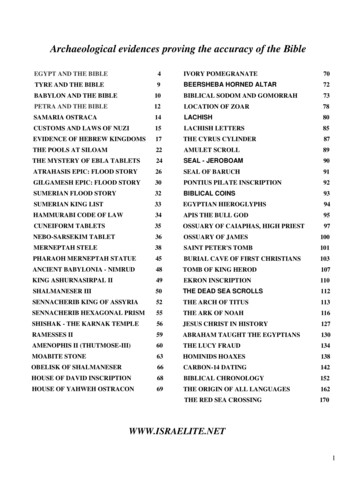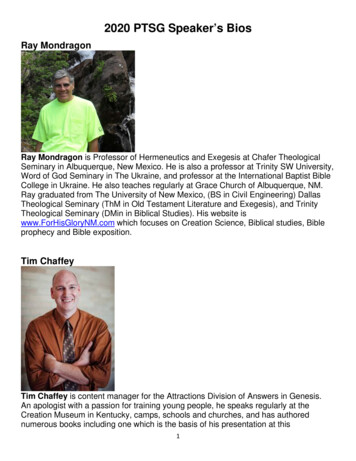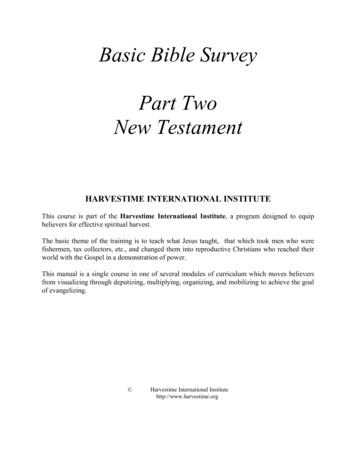
Transcription
Basic Bible SurveyPart TwoNew TestamentHARVESTIME INTERNATIONAL INSTITUTEThis course is part of the Harvestime International Institute, a program designed to equipbelievers for effective spiritual harvest.The basic theme of the training is to teach what Jesus taught, that which took men who werefishermen, tax collectors, etc., and changed them into reproductive Christians who reached theirworld with the Gospel in a demonstration of power.This manual is a single course in one of several modules of curriculum which moves believersfrom visualizing through deputizing, multiplying, organizing, and mobilizing to achieve the goalof evangelizing. Harvestime International Institutehttp://www.harvestime.org
TABLE OF CONTENTSHow To Use This Manual.Suggestions For Group Study.Course Introduction .Course Objectives.III12THE NEW TESTAMENTIntroduction To The Gospels1. Matthew .2. Mark.3. Luke.4. John.34172332Introduction To The Book Of History5. 0199.205206214Introduction To The Letters6. Romans .7. I and II Corinthians8. Galatians .9. Ephesians.10. Philippians.11. Colossians.12. I and II Thessalonians13. I and II Timothy .14. Titus.15. Philemon .16. Hebrews .17. James.18. I and II Peter.19. I, II, and III John20. Jude.Introduction To The Book Of Prophecy21. Revelation.Answers To Self-Tests.
HOW TO USE THIS MANUALMANUAL FORMATEach lesson consists of:Objectives: These are the goals you should achieve by studying the chapter. Read them beforestarting the lesson.Key Verse: This verse emphasizes the main concept of the chapter. Memorize it.Chapter Content: Study each section. Use your Bible to look up any references not printed inthe manual.Self-Test: Take this test after you finish studying the chapter. Try to answer the questionswithout using your Bible or this manual. When you have concluded the Self-Test, check youranswers in the answer section provided at the end of the book.For Further Study: This section will help you continue your study of the Word of God,improve your study skills, and apply what you have learned to your life and ministry.Final Examination: If you are enrolled in this course for credit, you received a finalexamination along with this course. Upon conclusion of this course, you should complete thisexamination and return it for grading as instructed.ADDITIONAL MATERIALS NEEDEDYou will need a King James version of the Bible.I
SUGGESTIONS FOR GROUP STUDYFIRST MEETINGOpening: Open with prayer and introductions. Get acquainted and register the students.Establish Group Procedures: Determine who will lead the meetings, the time, place, and datesfor the sessions.Praise And Worship: Invite the presence of the Holy Spirit into your training session.Distribute Manuals To Students: Introduce the manual title, format, and course objectivesprovided in the first few pages of the manual.Make The First Assignment: Students will read the chapters assigned and take the Self-Testsprior to the next meeting. The number of chapters you cover per meeting will depend on chapterlength, content, and the abilities of your group.SECOND AND FOLLOWING MEETINGSOpening: Pray. Welcome and register any new students and give them a manual. Takeattendance. Have a time of praise and worship.Review: Present a brief summary of what you studied at the last meeting.Lesson: Discuss each section of the chapter using the HEADINGS IN CAPITAL BOLDFACED LETTERS as a teaching outline. Ask students for questions or comments on whatthey have studied. Apply the lesson to the lives and ministries of your students.Self-Test: Review the Self-Tests students have completed. (Note To Instructor: If you do notwant the students to have access to the answers to the Self-Tests, you may remove the answerpages from the back of each manual.)For Further Study: You may do these projects on a group or individual basis.Final Examination: If your group is enrolled in this course for credit, you received a finalexamination with this course. Reproduce a copy for each student and administer the exam uponconclusion of this course.II
Module:Course:DeputizingBasic Bible SurveyINTRODUCTIONThe many references to the Old Testament by Jesus during His earthly ministry illustrate theimportance He placed on knowing the content of the Scriptures. Because Jesus stressed theimportance of God's Word to the men He trained, Harvestime International Institute presents thiscourse, "Basic Bible Survey," as part of its training program to equip men and women to reachtheir nations with God's message.Volume One of "Basic Bible Survey" introduces the Bible and discusses its translations andvarious versions. It presents an overview of Biblical history, geography, and life in Bible times.It also teaches outlining skills and presents an outline for each book in the Old Testament.This manual, Volume Two, continues the study with an outline for each book in the NewTestament. Information presented on each Bible book includes the author, the people to whomthe book was written, the purpose of the book, the key verse, a list of main characters, and anoutline of the content.A Life and Ministry Principle is also stated for each book. These principles are basic truths vitalto Christian maturity and ministry which you should seek to incorporate into your own life.Helpful charts, maps, and time lines summarizing important facts in condensed form are alsoincluded in both volumes of "Basic Bible Survey.""Basic Bible Survey" is a companion course of "Creative Bible Study Methods" which teachesvarious ways to study the Bible. Both courses are designed to enrich your personal study of God'sWord.1
COURSE OBJECTIVESUpon completion of this course you will be able to: Create and expand outlines of books of the New Testament. For each New Testament book, state the following:-Author-To whom the book was written-When it was written-Purpose of the book-Key Verse-Life and Ministry Principle Continue with a more detailed study of God's Word upon completion of this course.2
INTRODUCTION TO THE GOSPELSThe first four books in the New Testament are the Gospels. These books record the birth, life,ministry, teachings, death, and resurrection of Jesus Christ. The approach of each book differs:Matthew: Emphasizes Jesus Christ as King and was directed especially to the Jews. Thebook opens with the royal genealogy and closes with the King commissioning His disciples.Mark: Emphasizes Jesus Christ as the Servant of God and was directed to the Romans. Nogenealogy is given since Jesus is portrayed as a servant and no one is interested in the pedigree ofa servant. The book closes with the Lord "working with them," laboring as a servant with Hisdisciples.Luke: Presents Jesus Christ as the "Son of Man," the perfect man and Savior of imperfect men.Luke 3 traces the human genealogy of Jesus back to Adam. Luke ends with this perfect man,Jesus, ascending back up to Heaven to His Father.John: Stresses Jesus in His position as the Son of God. The book opens with Jesus the Wordrevealed as God. The closing verse of John indicates that the world could not contain all Jesusdid during His earthly ministry. This is further evidence He was truly the Son of God.JEWISH SECTSThe Jews of New Testament times belonged to different sects or groups. The following groupsare mentioned in the Gospels:Pharisees: Their religion centered on obedience to the law which they interpreted, extended,followed, and enforced. They followed not only the written law but also oral tradition which hadbeen passed from generation to generation. They were the largest group of Jews and the mostinfluential. They believed in resurrection after death.Sadducees: They were the governing group. They did not believe in the resurrection. Theyaccepted only the teaching written in the law and not what had been handed down orally. Theywere aligned politically with the Romans who ruled Israel at the time of Christ.Essences: These were strict legalists who looked for two messiahs to come. They lived insegregated communities.Zealots: These were fanatical nationalists who advocated violence as a means of liberationfrom Roman rule.3
CHAPTER ONEMATTHEWOBJECTIVES:Upon completion of this chapter you will be able to: Name the author of the book of Matthew.Identify to whom the book of Matthew was written.State the purpose for the book of Matthew.Write the Key Verses of the book of Matthew from memory.State the Life and Ministry Principle for the book of Matthew.INTRODUCTIONAUTHOR: MatthewTO WHOM: To all believers, although the first intended audience was the Jews to whom hepresented Jesus as the Messiah, the Son of David.PURPOSE: To present the ministry of Jesus, stressing His role as King of the Jews.KEY VERSES: Matthew 28:19-20LIFE AND MINISTRY PRINCIPLE: The final command of Jesus to His followers was togo to all nations with the Gospel.MAIN CHARACTERS: Jesus, the twelve disciplesOUTLINEPart One: The Genealogy Of The King 1:1-17I.Introduction: 1:1II.People in the genealogy: 1:2-16III.The plan of the genealogy: 1:174
Part Two: The Birth Of The King 1:18-2:23I.The conception: 1:18-23II.The birth: 1:24-25III.Events related to the birth: 2:1-23A.B.C.D.Visit of the wise men and Herod's plot: 2:1-12The flight into Egypt: 2:13-15Herod's revenge: 2:16-18Return to the Nazareth home: 2:19-23Part Three: Preparation 3:1-4:11I.Preparation for the King's coming: 3:1-17A.B.II.The ministry and message of John the Baptist: 3:1-12The baptism of the King: 3:13-17Preparation of the King: 4:1-11A.B.C.His humanity attacked by Satan: 4:1-4His divinity attacked by Satan: 4:5-7His Lordship attacked by Satan: 4:8-11Part Four: Ministry Of The King In Galilee 4:12-13:58I.A call to repentance: 4:12-17II.Four fishermen called to discipleship: 4:18-22III.Early success and fame: 4:23-25IV.Principles of conduct for Kingdom citizens: 5:1-7:28A.B.C.Attitudes that should characterize Kingdom citizens: 5:1-12The witness of Kingdom citizens: Light and salt: 5:13-16Kingdom principles in relation to the law and the prophets: 5:17-48l.God's law in general: 15:17-202.The new law: 15:21-48a.Killing: 15:21-26b.Adultery: 15:27-30c.Divorce: 15:31-325
D.E.F.G.H.V.d.Oaths: 15:33-37e.Treatment of others: 15:38-48Three attitudes of worship in the Kingdom: 6:1-181.Giving: Outward look: 6:1-42.Praying: Upward look: 6:5-153.Fasting: Inward look: 6:16-18Priorities for Kingdom citizens: 6:19-33l.In relation to values: 6:19-212.In relation to service: 6:22-243.In relation to material needs: 6:25-344.The proper priority: The Kingdom: 6:33Proper conduct for Kingdom citizens: 7:1-29l.Judging: 7:1-52.Care for that which is holy: 7:63.Prayer: 7:7-12a.Three kinds of prayer: Asking, seeking, knocking: 7:7-8b.A comparison between the response of natural fathers and theHeavenly Father: 7:9-11Special warnings to Kingdom citizens: 7:13-29l.Two gates: 7:13-142.False prophets: 7:15-203.The proof of God's man: Doing His will: 7:21-234.A comparison of wise and foolish men: 7:24-27Astonishment at the doctrine of Jesus: 7:28-29The authority of the King: 8:1-9:38A.B.C.D.E.F.G.H.Authority over disease: 8:1-17l.Healing of a leper: 8:1-42.Healing of the Centurion's servant: 8:5-133.Healing of Peter's mother-in-law: 8:14-154.Healing of all types of diseases: 8:16-17Authority over His disciples: 8:18-22Authority over natural elements: 8:23-27Authority over demons: 8:28-34Authority over sin: 9:1-8Authority over men: 9:9-17l.The calling of Matthew: 9:92.Eating with sinners: 9:10-133.Answering a challenge: 9:14-17Authority over death: The ruler's daughter: 9:18-19, 23-26Authority over physical conditions: 9:20-38l.Woman with the issue of blood: 9:20-222.Blindness: 9:27-316
3.4.Deafness and demon possession: 9:32-34The compassion of Jesus: 9:35-38VI.Commissioned by the King: 10:1-42A.The twelve missionaries and their authority: 10:1-4B.Instructions for the journey: 10:5-42l.Where to go: 10:5-62.The ministry: 10:7-83.Material instructions: 10:9-154.Spiritual instructions: 10:16-42VII.Attitudes towards the Kingdom: 11:1-30A.B.C.D.VIII.The Kingdom misunderstood: 11:1-11The Kingdom perverted: 11:12-19The Kingdom rejected: 11:20-24The Kingdom accepted: 11:25-30Controversies with the Pharisees: 12:1-14A.B.C.Harvesting on the Sabbath: 12:1-8Healing on the Sabbath: 12:9-13The results: 12:14-21IX.The unpardonable sin: 12:22-37X.Christ's reply to demands of the Pharisees: 12:38-45XI.The priority of spiritual over physical relationships in the Kingdom: 12:46-50XII.Parables of the Kingdom: 13:1-53A.B.C.D.E.F.G.H.I.J.K.L.Parable of the sower: 13:1-9The reason for speaking in parables: 13:10-17Interpretation of the parable of the sower: 13:18-23Parable of the tares: 13:24-30Parable of the mustard seed: 13:31-32Parable of the leaven: 13:33A summary concerning parables: 13:34-35Interpretation of the parable of the tares: 13:36-43Parable of the treasure hidden in a field: 13:44Parable of the pearl of great value: 13:45-46Parable of the dragnet: 13:47-50Concluding remarks about parables: 13:51-527
XIII.The King's reception in His home town: 13:53-58Part Five: Ministry In Regions Near Galilee 14:1-18:35I.The death of John the Baptist: 14:1-12II.Jesus' withdrawal beyond the sea: 14:13-15:20A.B.C.D.E.III.Jesus' withdrawal to the region of Tyre and Sidon: 15:21-28A.IV.Feeding the 5,000: 14:13-21Following for loaves and fishes: 14:22-23Walking on the sea: 14:24-33Ministry in Gennesaraet: 14:34-36Controversy with the Pharisees and Scribes: 15:1-20The women of Tyre and Sidon: 15:21-28Jesus' withdrawal to the vicinity of Decapolis: 15:29-38A.B.Healing ministry near the Sea of Galilee: 15:29-31Feeding the 4,000: 15:32-38V.Ministry in the regions of Magadan: 15:39-16:4VI.Warning the disciples concerning the Pharisees and the Sadducees: 16:5-12A.B.VII.Withdrawal to Caesarea-Philippi: 16:13-17:21A.B.C.D.VIII.Seeking for a sign: 16:1-4Warning concerning their doctrine: 16:5-12Testing the disciples: 16:13-20Announcement of His death, resurrection, and return: 16:21-28The transfiguration: 17:1-13Healing of a lunatic: 17:14-20A brief visit to Galilee: 17:22-18:35A.B.C.D.A reminder of His death and resurrection: 17:22-23Paying the temple tax: 17:24-27A lesson in greatness: 18:1-6Warnings concerning offenses: 18:7-98
E.F.Parable of the lost sheep: 18:10-14Settling disputes among Kingdom citizens: 18:15-351.How to settle disputes: 18:15-172.The responsibilities and privileges of Kingdom citizens: 18:18-203.A question on forgiveness: 18:21-224.The King and his debtors: 18:23-35Part Six: Ministry Of The King In Perea 19:1-20:34I.Healing multitudes in Judea: 19:1-2II.The question concerning divorce: 19:3-12III.Children blessed by Jesus: 19:13-15IV.Interview with the rich young ruler: 19:16-22V.The peril of riches: 19:23-30VI.Parable of the householder: 20:1-16VII.Impending death and resurrection of Jesus: 20:17-19VIII.A mother's selfish request: 20:20-28IX.Two blind men healed near Jericho: 20:29-34Part Seven: The King's Last Week 21:1-27:31I.The royal entry into Jerusalem: 21:1-11II.Cleansing the temple: 21:12-17III.The fig tree cursed: 21:18-22IV.The authority of Jesus challenged: 21:23-32V.Parable of the wicked husbandmen: 21:33-46VI.Parable of the marriage feast: 22:1-14VII.Attempts to discredit Jesus: 22:15-45A.Question of paying taxes to Caesar: 22:15-229
B.C.D.VIII.Discussion concerning the Scribes and Pharisees: 23:1-39A.B.C.D.E.F.IX.They pretend religious authority: 23:1-3They impose burdens: 23:4They covet praise: 23:5-7Advice to His disciples: 23:8-12Woes upon the Scribes and Pharisees: 23:13-36The cry over Jerusalem: 23:37-39The future of the Kingdom: 24:1-25:46A.B.C.D.E.F.G.H.X.Question concerning the resurrection: 22:23-33Question of the great commandment: 22:34-40Questions by Jesus: 22:41-46The destruction of the temple: 24:1-2Signs of the end: 24:3-14The tribulation period: 24:15-22The return of Jesus: 24:23-31Parable of the fig tree: 24:32-35The day of the Lord: 24:36-41The command to watch: 24:42-51Parables concerning the end times: 25:1-46l.The ten virgins: 25:1-132.The talents: 25:14-303.The sheep and goats: 25:31-46Events prior to the crucifixion: 26:1-27:31A.B.C.D.E.F.G.H.Announcement of approaching death: 26:1-2The plot to kill Jesus: 26:3-5Anointed for burial: 26:6-13Agreement of Judas to betray Jesus: 26:14-16The Last Supper: 26:17-29l.Preparations for the Passover: 26:17-192.The Last Supper: 26:20-293.Jesus' warning and Peter's boast: 26:30-35Gethsemane: 26:36-46Betrayal and arrest: 26:47-56The trials of Jesus: 26:57-27:2610
Part Eight: The King's Death And Triumph 27:27-28:20I.The crucifixion and burial: 27:27-66A.B.C.The mockery of the soldiers: 27:27-31The road to and death on Calvary: 27:32-54The faithful women, the burial, and tomb guard: 27:55-66II.The resurrection: 28:1-15III.The Great Commission: 28:16-2011
SELF-TEST1.Who was the author of the book of Matthew?2.State the purpose for the book of Matthew.3.To whom was the book of Matthew written?4.State the Life and Ministry Principle of the book of Matthew.5.From memory, write the Key Verse of Matthew.(Answers to tests are provided at the conclusion of the final chapter in this manual.)12
FOR FURTHER STUDY1.The book of Matthew can be viewed in three groups of ten incidents: The Sermon on theMount consists of 10 principal components (chapters 5-6). The next chapters (8-10)record 10 miracles. The next group of chapters (11-18) record 10 representative reactionsby people to Jesus. Study Matthew using this pattern.2.Study the life of Matthew. He was a publican (Matthew 5:3). He became a disciple ofJesus (Matthew 9:9). He was later appointed an apostle (Matthew 10:3) and he becamethe writer of this Gospel which bears His name.3.Study the temptation of Jesus in Matthew 4. Use the chart to help you understand thestory of the temptation:The Temptation Of ChristThe TemptationRealm OfTemptationThe "ifs"Christ's AnswerFrom ScriptureStonesPhysical(hunger)If Thou be God's SonDeuteronomy 8:3Pinnacle ofthe TempleSpiritualIf Thou be God's sonPsalms 91:11-12Deuteronomy 6:16Kingdoms ofthe worldMaterialIf Thou willworship meDeuteronomy 6:134.In Matthew chapters 1 and 2 there are several Old Testament Scriptures quoted.Compare the following:Matthew 1:23Matthew 2:2Matthew 2:6Matthew 2:15Matthew 2:18Matthew 2:23Isaiah 7:14Jeremiah 23:5; Zechariah 9:9Micah 5:2Hosea 11:1; Exodus 4:22Jeremiah 31:15Isaiah 11:15.From Matthew chapter 10 list as many characteristics of discipleship as you can find.6.Study Matthew 20:17-28. List the contrasts between worldly leaders and the leadershipdescribed by Jesus.13
7.Read Matthew 23 and list at least 10 commandments for Christian leaders.8.Study the following Old Testament references related to Matthew 21:1-17: Zechariah9:9; II Kings 9:13; Exodus 30:13; Psalms 118:26; Leviticus 1:14; Isaiah 56:7;Jeremiah 7:11; Psalms 8:29.Study the following key words in Matthew: Kingdom, Heaven, Kingdom of Heaven,10.Study the prayers of Jesus:-At His baptism:-In a solitary place:-In the wilderness:-All night before choosing the disciples:-Before His invitation, "Come unto Me":-At the feeding of the 5,000:-After the feeding of the 5,000:-When He gave the Lord's prayer:-At Caesarea-Philippi:-Before His transfiguration:-For little children:-Before the raising of Lazarus from the dead:-In the temple:-At the supper:-For Peter:-For the disciples and His future followers:-In Gethsemane:-On the cross:-At Emmaus:14Luke 3:21Mark 1:35Luke 5:16Luke 6:12Matthew 11:25-27John 6:11Matthew 14:23Luke 11:1-4Luke 9:18Luke 9:28-29Matthew 19:13John 11:41-42John 12:27-28Matthew 26:26-27Luke 22:32John 17Matthew 26:36,39,42,44Luke 23:24Luke 24:30
11.Study the miracles of Jesus:LeperCenturion's servantPeter's mother-in-lawTwo GadarenesParalyzed manWoman with hemorrhageTwo blind menMan dumb and possessedWithered handBlind, dumb possessedCanaanite woman's girlBoy with epilepsyBlind menDeaf and dumb manMan possessed, synagogueBlind man at BethsaidaWoman bent doubleMan with dropsyTen lepersMalchus' earOfficial's sonSick man, BethesdaMan born blindCalming stormWalking on water5,000 fed4,000 fedCoin in fish's mouthFig tree witheredCatch of fishWater into wineAnother catch of fishJarius' daughterWidow's 8:41-567:11-1511:1-4415
12.Study the parables of Jesus:Lamp under a bushelHouse on rockNew clothNew wineSower and soilsMustard seedTaresLeavenHidden treasurePearlDrag netLost sheepTwo debtorsWorkers in vineyardTwo sonsWicked tenantsWedding feastFig treeTen bridesmaidsTalents/poundsSheep and goatsSeed time to harvestCreditor and the debtorsGood SamaritanFriend in needRich foolAlert servantsFaithful stewardFig tree without figsPlaces of honorGreat banquetCounting the costLost coinProdigal sonDishonest stewardRich man and LazarusMaster and servantPersistent widowPharisee and tax :1-1325:14-3025:31-364:21-228:16; -3216:1-816:19-3117:7-1018:2-518:10-1416
CHAPTER TWOMARKOBJECTIVES:Upon completion of this chapter you will be able to: Name the author of the book of Mark.Identify to whom the book of Mark was written.State the purpose for the book of Mark.Write the Key Verse of the book of Mark from memory.State the Life and Ministry Principle for the book of Mark.INTRODUCTIONAUTHOR: MarkTO WHOM: To all believers, although the first intended audience was the Romans to whomhe presents Jesus as a servant.PURPOSE: To present the ministry of Jesus, stressing His role as a servant and the Son ofman.KEY VERSE: Mark 10:45LIFE AND MINISTRY PRINCIPLE: We should seek to minister rather than to beministered to.MAIN CHARACTERS: Jesus, the twelve disciplesOUTLINEI.The period of preparation: 1:1-13A.B.C.D.II.The beginning of the Gospel: 1:1-3The ministry of John the Baptist: 1:4-8The baptism of Jesus: 1:9-11The temptation of Jesus: 1:12-13The Galilean Ministry: 1:14-6:3017
III.The beginning of the ministry of Jesus: 1:14-15The call of four fisherman: 1:16-20Healing of a demon possessed man: 1:21-28Healing of Peter's mother-in-law: 1:29-31Growing popularity: 1:32-34The quiet time: 1:35-37The first tour of Galilee: 1:38-39Healing of a leper: 1:40-45Healing of a paralyzed man: 2:1-12The call of Matthew: 2:13-14A celebration, criticism, and reply: 2:15-22The Sabbath controversy: 2:23-3:6Ministry by the sea: 3:7-12The ordaining of the twelve disciples: 3:13-19The zeal of Jesus: 3:20-21The unpardonable sin: 3:22-30True relationship with Jesus: 3:31-35A series of parables: 4:1-34l.The parable of the soils: 4:1-202.The parable of the lamp: 4:21-253.The parable of gradual growth: 4:26-294.The parable of the mustard seed: 4:30-34A storm at sea: 4:35-41The healing of a demoniac: 5:1-20The daughter of Jarius and the woman with the issue of blood: 5:21-43Rejection at Nazareth: 6:1-6The mission of the twelve disciples: 6:7-13The death of John the Baptist: 6:14-29The report of the twelve: 6:30The period of withdrawal: 6:31-9:50A.B.C.D.E.F.G.H.I.J.K.L.The feeding of the 5,000: 6:31-46Walking on water: 6:47-52The ministry at Gennesaret: 6:53-56The rebuking of the Pharisees: 7:1-23The Syrophoenician woman: 7:24-30Healing of a deaf mute: 7:31-37Feeding of the 4,000: 8:1-9A demand for a sign: 8:10-13A warning about leaven: 8:14-21Healing of the blind man: 8:22-26An examination and lesson at Caesarea Philippi: 8:27-9:1The transfiguration of Jesus: 9:2-1018
M.N.O.IV.The ministry in Perea and Judea: 10:1-52A.B.C.D.E.F.G.H.V.The problem of Elias: 9:11-13The healing of a demoniac boy: 9:14-29Final teaching in Galilee: 9:30-50A lesson about divorce: 10:1-12The blessing of children: 10:13-16The rich young ruler: 10:17-22A warning on the peril of riches: 10:23-27A discussion concerning rewards: 10:28-31The prediction of Jesus' death: 10:32-34A request for prominence: 10:35-45The healing of Bartimaeus: 10:46-52Events of the final week: U.V.W.X.Y.Z.The royal entry to Jerusalem: 11:1-11Cursing the barren fig tree: 11:12-14Cleansing of the temple: 11:15-19A lesson about faith: 11:20-26A challenge to Christ's authority: 11:27-33The parable of the husbandmen: 12:1-12A question about tribute: 12:13-17The problem of the resurrection: 12:18-27A question about the Great Commandment: 12:28-34A question about the Christ: 12:35-37A warning against Scribes: 12:38-40The widow's mite: 12:41-44Faith for the future: 13:1-37The plot of the Sanhedrin: 14:1-2Dinner in Bethany: 14:3-9The plot of Judas: 14:10-11The Passover: 14:12-21The Last Supper: 14:22-26Peter's denial foretold: 14:27-31Prayer in Gethsemane: 14:32-42The betrayal and arrest: 14:43-52The Jewish trial: 14:53-65The denials of Peter: 14:66-72The Roman trial: 15:1-21The crucifixion of Jesus: 15:22-41The burial of Jesus: 15:42-4719
VI.The resurrection of Jesus: 16:1-8A.B.C.VII.First at the tomb: 16:1-3The empty tomb: 16:4-6The commission to preach the resurrection message: 16:7-8The appearances of Jesus: 16:9-14A.B.C.To Mary Magdalene: 16:9-11To two disciples: 16:12-13To the eleven disciples: 16:14VIII.The Great Commission: 16:15-18IX.The ascension of Jesus to Heaven: 16:19X.Fulfilling the Commission: 16:2020
SELF-TEST1.Who was the author of the book of Mark?2.State the purpose for the book of Mark.3.To whom was the book of Mark written?4.State the Life and Ministry Principle of the book of Mark.5.From memory, write the Key Verse of Mark.(Answers to tests are provided at the conclusion of the final chapter in this manual.)21
FOR FURTHER STUDY1.Study the key words of the book of Mark: Straightway, forthwith, and immediately.2.Study the life of Mark, the author of this book which bears his name. See Acts 12:12,25;13:5,13; 15:37-39; Colossians 4:10; Philemon 23-24; and I Peter 5:13.3.Jesus appeared many times after His resurrection, confirming that He truly did rise fromthe dead. He appeared to the following:-Mary Magdalene:-The other women:-Two disciples on the way to Emmaus:-Peter:-The disciples without Thomas:-The disciples with Thomas:-The seven beside the Sea of Galilee:-The disciples in Galilee:-James:-Those with Him on the Mount of Ascension:-Paul:4.Mark 16:9-10Matthew 28:9-10Mark 16:12-13; Luke 24:13-32Luke 24:34Mark 16:14; Luke 24:36; John 29:19John 20:26-31John 21Matthew 28:16-20I Corinthians 15:7Mark 16:19; Luke 24:44; Acts 1:3I Corinthians 15:5-8Jesus faced many false accusations from His enemies. Study Mark 2:1-3:6 and completethe following sersAccusationSpoken to whomJesus' defenseResult22
CHAPTER THREELUKEOBJECTIVES:Upon completion of this chapter you will be able to: Name the author of the book of Luke.Identify to whom the book of Luke was written.State the purpose for the book of Luke.Write the Key Verse of the book of Luke from memory.State the Life and Ministry Principle for the book of Luke.INTRODUCTIONAUTHOR: LukeTO WHOM: All believers, although the first intended audience was the Greeks to whom hepresented Jesus as the perfect man. He also addresses one specific believer, Theophilus.PURPOSE: The purpose is to write an orderly account of the ministry of Jesus (Luke 1:1-4).KEY VERSE: Luke 19:10LIFE AND MINISTRY PRINCIPLE: Our mission is identical to that of Jesus: To reach thelost with the good news of the Gospel.MAIN CHARACTERS: Jesus, the twelve disciplesOUTLINEPart One: Preparation 1:1-2:52I.Introduction:A.B.C.D.E.The note to Theophilus: 1:1-4The vision of Zechariah: 1:5-25The vision of Mary: 1:26-38The visit of Mary to Elizabeth: 1:39-56The birth of John the Baptist: 1:57-8023
II.Birth and childhood of Jesus:A.The birth of Jesus: 2:1-7B.The visit of the shepherds: 2:8-20C.The circumcision and naming of Jesus: 2:21D.The presentation of Jesus: 2:22-40E.The visit of Jesus to the Temple: 2:41-52Part Two: The Beginning Of Christ's Ministry 3:1-4:3I.The ministry of John the Baptist: 3:1-20II.The baptism of Jesus: 3:21-22III.The genealogy of Jesus: 3:23-38IV.The temptation of Jesus: 4:1-13Part Three: Jesus In Galilee 4:14-9:62I.The rejection of Jesus in Nazareth: 4:14-30II.The demon possessed man in the synagogue at Capernaum: 4:31-37III.The healing of Peter's mother-in-law: 4:38-39IV.Further miracles and preaching: 4:40-44V.A miraculous catch of fish and the call of Simon Peter, James, and John: 5:1-11VI.The cleansing of a leper: 5:12-16VII.The forgiving and healing of a paralyzed man: 5:17-26VIII.The call of Matthew: 5:27-28IX.The feast with publicans: 5:29-32X.Remarks about fasting: 5:33-39XI.Plucking and eating grain on the Sabbath: 6:1-5XII.Healing of a withered hand: 6:6-11XIII.Choice of the twelve disciples: 6:12-1624
XIV.The sermon on the Mount: 6:17-49XV.Healing of a centurion's servant: 7:1-10XVI.Raising a widow's son from the dead: 7:11-17XVII.The question of John the Baptist: 7:18-35XVIII.Anointing by and forgiveness of the sinful woman: 7:36-50XIX.Preaching with support from certain women: 8:1-3XX.The pa
included in both volumes of "Basic Bible Survey." "Basic Bible Survey" is a companion course of "Creative Bible Study Methods" which teaches various ways to study the Bible. Both courses are designed to e

